2018 HONDA CLARITY FUEL CELL lock
[x] Cancel search: lockPage 397 of 551
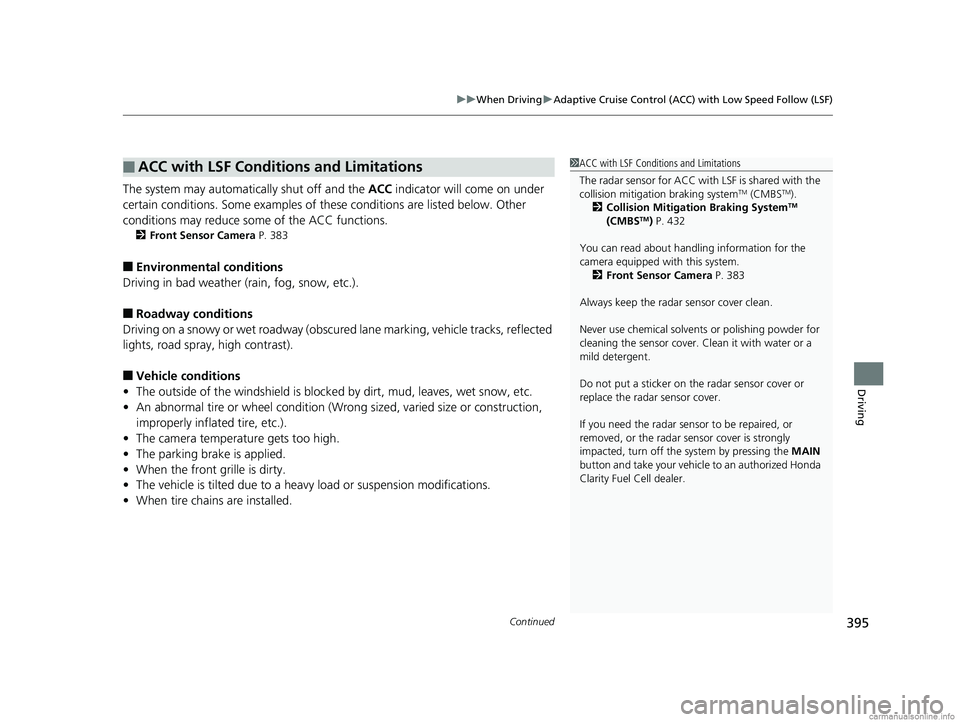
Continued395
uuWhen Driving uAdaptive Cruise Control (ACC) with Low Speed Follow (LSF)
Driving
The system may automatically shut off and the ACC indicator will come on under
certain conditions. Some examples of these conditions are listed below. Other
conditions may reduce some of the ACC functions.
2 Front Sensor Camera P. 383
■Environmental conditions
Driving in bad weather (r ain, fog, snow, etc.).
■Roadway conditions
Driving on a snowy or wet roadway (obscure d lane marking, vehicle tracks, reflected
lights, road spra y, high contrast).
■Vehicle conditions
• The outside of the windshield is blocked by dirt, mud, leaves, wet snow, etc.
• An abnormal tire or wheel condition (Wrong sized, varied size or construction,
improperly inflated tire, etc.).
• The camera temperature gets too high.
• The parking brake is applied.
• When the front grille is dirty.
• The vehicle is tilted due to a heavy load or suspension modifications.
• When tire chains are installed.
■ACC with LSF Conditions and Limitations1ACC with LSF Conditions and Limitations
The radar sensor for ACC with LSF is shared with the
collision mitigation braking system
TM (CMBSTM).
2 Collision Mitigation Braking SystemTM
(CMBSTM) P. 432
You can read about handling information for the
camera equipped with this system. 2 Front Sensor Camera P. 383
Always keep the radar sensor cover clean.
Never use chemical solvents or polishing powder for
cleaning the sensor cover. Clean it with water or a
mild detergent.
Do not put a sticker on the radar sensor cover or
replace the radar sensor cover.
If you need the radar sensor to be repaired, or
removed, or the radar se nsor cover is strongly
impacted, turn off the system by pressing the MAIN
button and take your vehicl e to an authorized Honda
Clarity Fuel Cell dealer.
18 CLARITY FUEL CELL PPO-31TRT6100.book 395 ページ 2017年11月21日 火曜日 午後3時3分
Page 413 of 551
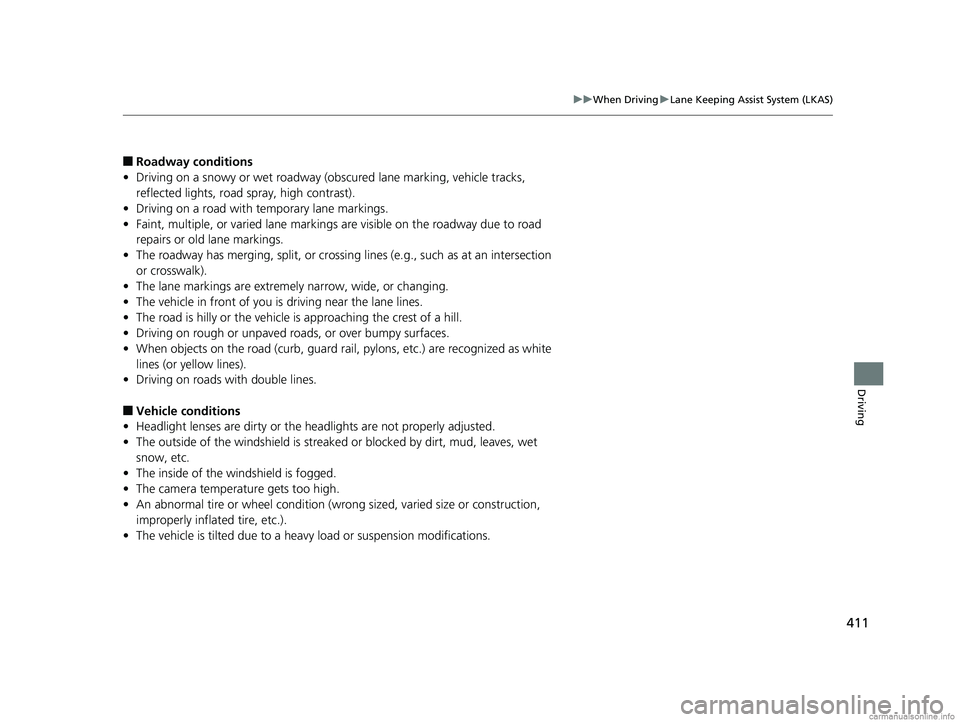
411
uuWhen Driving uLane Keeping Assist System (LKAS)
Driving
■Roadway conditions
• Driving on a snowy or wet roadway (obs cured lane marking, vehicle tracks,
reflected lights, road spray, high contrast).
• Driving on a road with temporary lane markings.
• Faint, multiple, or varied lane markings are visible on the roadway due to road
repairs or old lane markings.
• The roadway has merging, split, or crossing lines (e.g., such as at an intersection
or crosswalk).
• The lane markings are extremely narrow, wide, or changing.
• The vehicle in front of you is driving near the lane lines.
• The road is hilly or the vehicle is approaching the crest of a hill.
• Driving on rough or unpaved roads, or over bumpy surfaces.
• When objects on the road (curb, guard rail, pylons, etc.) are recognized as white
lines (or yellow lines).
• Driving on roads with double lines.
■Vehicle conditions
• Headlight lenses are dirty or the h eadlights are not properly adjusted.
• The outside of the windshield is streaked or blocked by dirt, mud, leaves, wet
snow, etc.
• The inside of the windshield is fogged.
• The camera temperature gets too high.
• An abnormal tire or wheel condition (wrong sized, varied size or construction,
improperly inflated tire, etc.).
• The vehicle is tilted due to a heavy load or suspension modifications.
18 CLARITY FUEL CELL PPO-31TRT6100.book 411 ページ 2017年11月21日 火曜日 午後3時3分
Page 422 of 551
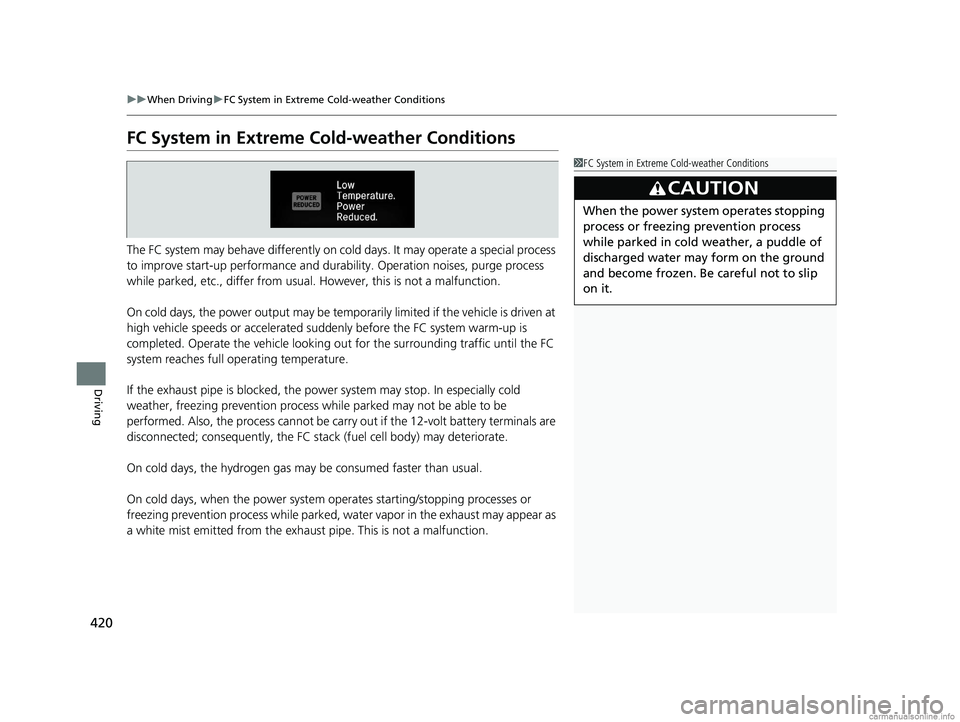
420
uuWhen Driving uFC System in Extreme Cold-weather Conditions
Driving
FC System in Extreme Cold-weather Conditions
The FC system may behave differently on cold days. It may operate a special process
to improve start-up performance and durabi lity. Operation noises, purge process
while parked, etc., differ from usual. However, this is not a malfunction.
On cold days, the power output may be temporarily limited if the vehicle is driven at
high vehicle speeds or accelerated sudd enly before the FC system warm-up is
completed. Operate the vehicle looking ou t for the surrounding traffic until the FC
system reaches full ope rating temperature.
If the exhaust pipe is blocked, the power system may stop. In especially cold
weather, freezing prevention process while parked may not be able to be
performed. Also, the process cannot be carry out if the 12-volt battery terminals are
disconnected; consequently, the FC st ack (fuel cell body) may deteriorate.
On cold days, the hydrogen gas may be consumed faster than usual.
On cold days, when the power system op erates starting/stopping processes or
freezing prevention process while parked, wa ter vapor in the exhaust may appear as
a white mist emitted from the exhaus t pipe. This is not a malfunction.
1FC System in Extreme Cold-weather Conditions
3CAUTION
When the power system operates stopping
process or freezing prevention process
while parked in cold weather, a puddle of
discharged water may form on the ground
and become frozen. Be careful not to slip
on it.
18 CLARITY FUEL CELL PPO-31TRT6100.book 420 ページ 2017年11月21日 火曜日 午後3時3分
Page 429 of 551
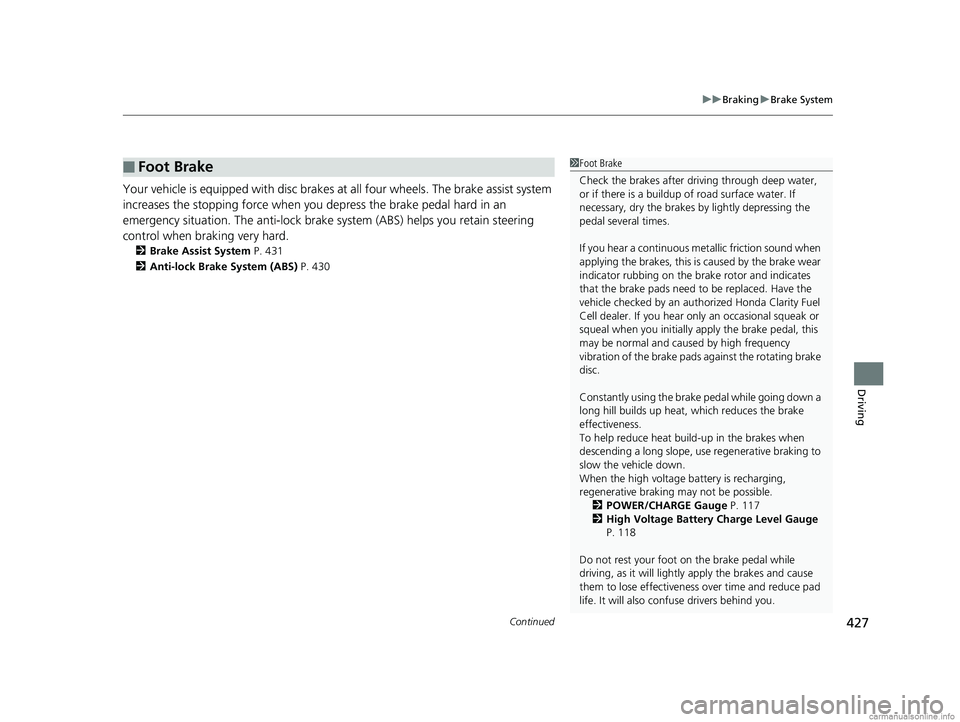
Continued427
uuBraking uBrake System
Driving
Your vehicle is equipped with disc brakes at all four wheels. The brake assist system
increases the stopping force when you depress the brake pedal hard in an
emergency situation. The an ti-lock brake system (ABS) helps you retain steering
control when brak ing very hard.
2Brake Assist System P. 431
2 Anti-lock Brake System (ABS) P. 430
■Foot Brake1Foot Brake
Check the brakes after driving through deep water,
or if there is a buildup of road surface water. If
necessary, dry the brakes by lightly depressing the
pedal several times.
If you hear a continuous me tallic friction sound when
applying the brakes, this is caused by the brake wear
indicator rubbing on the brake rotor and indicates
that the brake pads need to be replaced. Have the
vehicle checked by an authorized Honda Clarity Fuel
Cell dealer. If you hear onl y an occasional squeak or
squeal when you initially a pply the brake pedal, this
may be normal and caus ed by high frequency
vibration of the brake pads against the rotating brake
disc.
Constantly using the brak e pedal while going down a
long hill builds up heat, which reduces the brake
effectiveness.
To help reduce heat build -up in the brakes when
descending a long slope, use regenerative braking to
slow the vehicle down.
When the high voltage battery is recharging,
regenerative braking may not be possible.
2 POWER/CHARGE Gauge P. 117
2 High Voltage Battery Charge Level Gauge
P. 118
Do not rest your foot on the brake pedal while
driving, as it will lightly apply the brakes and cause
them to lose effectiveness over time and reduce pad
life. It will also conf use drivers behind you.
18 CLARITY FUEL CELL PPO-31TRT6100.book 427 ページ 2017年11月21日 火曜日 午後3時3分
Page 432 of 551
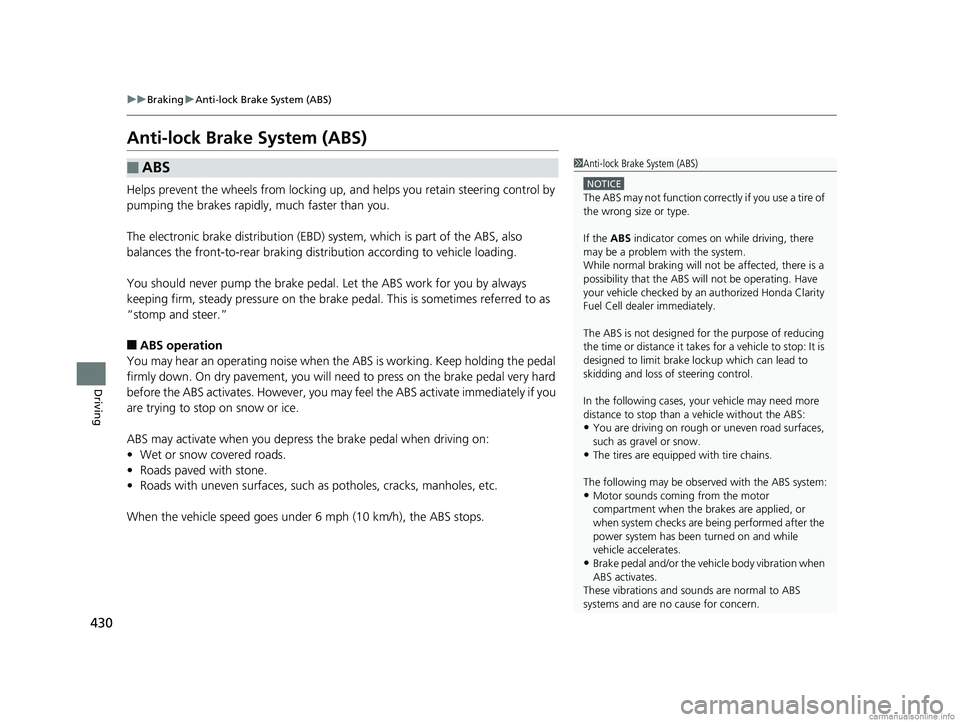
430
uuBraking uAnti-lock Brake System (ABS)
Driving
Anti-lock Brake System (ABS)
Helps prevent the wheels from locking up, a nd helps you retain steering control by
pumping the brakes rapidly, much faster than you.
The electronic brake distribution (EBD) system, which is part of the ABS, also
balances the front-to-rear braking distri bution according to vehicle loading.
You should never pump the brake pedal. Let the ABS work for you by always
keeping firm, steady pressure on the brake pe dal. This is sometimes referred to as
“stomp and steer.”
■ABS operation
You may hear an operating noise when the ABS is working. Keep holding the pedal
firmly down. On dry pavement, you will need to press on the brake pedal very hard
before the ABS activates. However, you may feel the ABS activate immediately if you
are trying to stop on snow or ice.
ABS may activate when you depress the brake pedal when driving on:
• Wet or snow covered roads.
• Roads paved with stone.
• Roads with uneven surfaces, such as potholes, cracks, manholes, etc.
When the vehicle speed goes unde r 6 mph (10 km/h), the ABS stops.
■ABS1Anti-lock Brake System (ABS)
NOTICE
The ABS may not function correc tly if you use a tire of
the wrong size or type.
If the ABS indicator comes on while driving, there
may be a problem with the system.
While normal braking will not be affected, there is a
possibility that the ABS wi ll not be operating. Have
your vehicle checked by an authorized Honda Clarity
Fuel Cell dealer immediately.
The ABS is not designed for the purpose of reducing
the time or distance it takes for a vehicle to stop: It is
designed to limit brake lo ckup which can lead to
skidding and loss of steering control.
In the following cases, yo ur vehicle may need more
distance to stop than a vehicle without the ABS:
•You are driving on rough or uneven road surfaces,
such as gravel or snow.
•The tires are equipped with tire chains.
The following may be observed with the ABS system:
•Motor sounds coming from the motor
compartment when the brakes are applied, or
when system checks are being performed after the
power system has been turned on and while
vehicle accelerates.
•Brake pedal and/or the ve hicle body vibration when
ABS activates.
These vibrations and sounds are normal to ABS
systems and are no cause for concern.
18 CLARITY FUEL CELL PPO-31TRT6100.book 430 ページ 2017年11月21日 火曜日 午後3時3分
Page 439 of 551
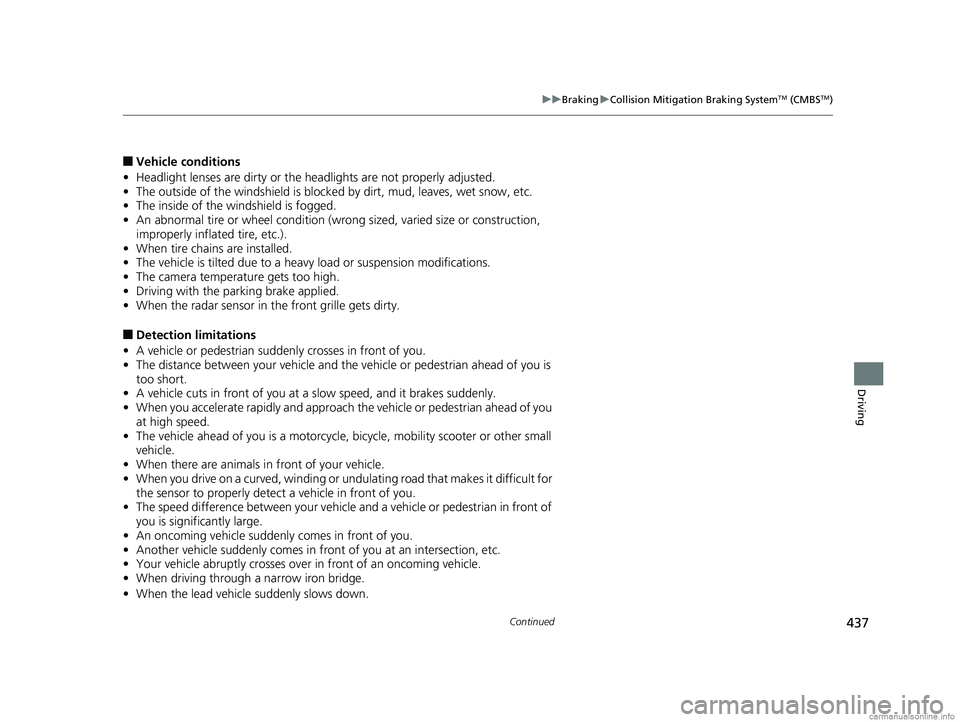
437
uuBraking uCollision Mitigation Braking SystemTM (CMBSTM)
Continued
Driving
■Vehicle conditions
• Headlight lenses are dirty or the h eadlights are not properly adjusted.
• The outside of the windshield is blocked by dirt, mud, leaves, wet snow, etc.
• The inside of the windshield is fogged.
• An abnormal tire or wheel condition (wrong sized, varied size or construction,
improperly inflated tire, etc.).
• When tire chains are installed.
• The vehicle is tilted due to a heavy load or suspension modifications.
• The camera temperature gets too high.
• Driving with the parking brake applied.
• When the radar sensor in the front grille gets dirty.
■Detection limitations
• A vehicle or pedestrian suddenly crosses in front of you.
• The distance between your vehicle and the vehicle or pedestrian ahead of you is
too short.
• A vehicle cuts in front of you at a slow speed, and it brakes suddenly.
• When you accelerate rapidly and approach the vehicle or pedestrian ahead of you
at high speed.
• The vehicle ahead of you is a motorcycle, bicycle, mobility scooter or other small
vehicle.
• When there are animals in front of your vehicle.
• When you drive on a curved, winding or und ulating road that makes it difficult for
the sensor to properly detect a vehicle in front of you.
• The speed difference between your vehicle an d a vehicle or pedestrian in front of
you is significantly large.
• An oncoming vehicle suddenly comes in front of you.
• Another vehicle suddenly comes in fr ont of you at an intersection, etc.
• Your vehicle abruptly crosses over in front of an oncoming vehicle.
• When driving through a narrow iron bridge.
• When the lead vehicle suddenly slows down.
18 CLARITY FUEL CELL PPO-31TRT6100.book 437 ページ 2017年11月21日 火曜日 午後3時3分
Page 443 of 551

441
uuParking Your Vehicle uWhen Stopped
Driving
Always confirm the electric parking brake is set, in particular if you are parked on an
incline.1When Stopped
In extremely cold temperatures, the parking brake
may freeze up if applied. If such temperatures are
expected, do not apply the parking brake but, if
parking on a slope, either turn the front wheels so
they will contact the curb if the vehicle rolls down the
slope or block the wheels to keep the vehicle from
moving. If you do not take either precaution, the
vehicle may roll unexpect edly, leading to a crash.
18 CLARITY FUEL CELL PPO-31TRT6100.book 441 ページ 2017年11月21日 火曜日 午後3時3分
Page 447 of 551
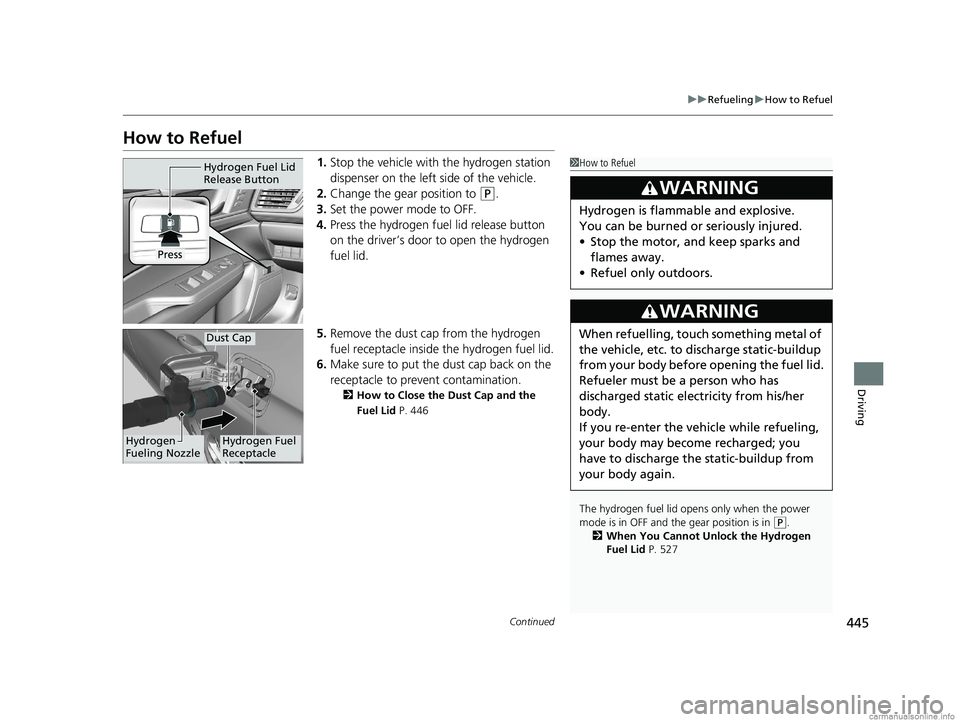
445
uuRefueling uHow to Refuel
Continued
Driving
How to Refuel
1. Stop the vehicle with the hydrogen station
dispenser on the left side of the vehicle.
2. Change the gear position to
(P.
3. Set the power mode to OFF.
4. Press the hydrogen fuel lid release button
on the driver’s door to open the hydrogen
fuel lid.
5. Remove the dust cap from the hydrogen
fuel receptacle inside the hydrogen fuel lid.
6. Make sure to put the dust cap back on the
receptacle to prevent contamination.
2 How to Close the Dust Cap and the
Fuel Lid P. 446
1How to Refuel
The hydrogen fuel lid ope ns only when the power
mode is in OFF and the gear position is in
( P.
2 When You Cannot Unlock the Hydrogen
Fuel Lid P. 527
3WARNING
Hydrogen is flamma ble and explosive.
You can be burned or seriously injured.
• Stop the motor, a nd keep sparks and
flames away.
• Refuel only outdoors.
3WARNING
When refuelling, touc h something metal of
the vehicle, etc. to discharge static-buildup
from your body before opening the fuel lid.
Refueler must be a person who has
discharged static elec tricity from his/her
body.
If you re-enter the vehicle while refueling,
your body may become recharged; you
have to discharge the static-buildup from
your body again.
Hydrogen Fuel Lid
Release Button
Press
Hydrogen
Fueling NozzleHydrogen Fuel
Receptacle
Dust Cap
18 CLARITY FUEL CELL PPO-31TRT6100.book 445 ページ 2017年11月21日 火曜日 午後3時3分